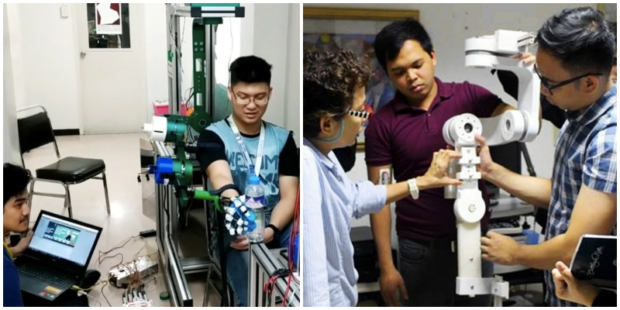DLSU’s robotic medical aid gets Singapore patent

‘SOMETHING THAT WOULD GIVE HOPE’ | Researchers at De La Salle University (DLSU) try out and examine the artificial exoskeleton which they designed to aid stroke patients. They now aim to secure patents from South Korea, the United States, and Vietnam. (Photos courtesy of DLSU)
MANILA, Philippines — A “wearable robot” developed by De La Salle University (DLSU) to help the rehabilitation of stroke and injured patients has received its first international patent from Singapore.
DLSU’s “Agapay” project, made in partnership with the University of the Philippines Manila and funded by the Department of Science and Technology (DOST), is aimed at creating a robotic exoskeleton that could support the rehabilitation therapy of patients. “Agapay” is a Filipino word that means to reinforce or support.
This is the “first attempt” in the country to facilitate therapy exercises using a robot, according to DLSU engineer and lead researcher Voltaire Dupo.
He pointed out that rehabilitation therapy here is currently “more traditional” and focused on physical therapy exercises.
Muscle movement
Dupo, who himself underwent physiotherapy due to shoulder and back problems, explained that rehabilitation medicine for stroke involves “rewiring” the brain to coordinate with the muscle movement.
Article continues after this advertisementThe wearable robot features a device placed on top of the arm muscle that could detect muscle twitches or movement.
Article continues after this advertisement“When the device detects the muscle twitch, instead of the patient being the one to pull the arm up, the robot will assist him or her. When the twitch stops, then the movement will also stop,” he said.
“We hope that this is something beneficial for the patient that would give hope and make them realize that they can still move their muscles and further encourage them to exercise,” he added.
Researchers said in their patent application that stroke and injury remained the two leading causes of disabilities in the Philippines.
They also noted that while there have been recent technological advances in the development of exoskeletons for rehabilitation, low-cost devices to support upper limb recovery “remained unavailable in developing regions.”
Other applications
The Singapore patent now grants DLSU the right to the invention and allows the university to work with foreign partners.
Researchers had also applied for patents in South Korea, the United States, and Vietnam, said Peter Immanuel Tenido, project director of the DLSU Innovation and Technology Office.
“We selected Singapore, Korea, Vietnam, and the US precisely because we thought the rehabilitation robotics industry is active in those countries,” he said in an interview on Friday.
“For example in Singapore, since we now have a patent, we can work with Singapore firms who can manufacture the technology there,” he added.
Faculty researcher Rennan Baldovino emphasized that researchers are still in the clinical trial phase.
Thus, there is no estimated pricing for the instrument this early. Furthermore, it is initially planned for deployment to remote localities needing access to medical care, he said.
“It’s not something that can be bought because one of the requirements is to have a physiotherapist that will act as an operator for the patient,” Baldovino said.
Still, he acknowledged that “We’ve been looking for different kinds of business models like, for example, if it will be rented as ‘robots as a service.’”
“We all know that robots are very expensive and have a high production cost,” he said.
‘Responsive technologies’
Nevertheless, Jaime Montoya, executive director of the DOST’s Philippine Council for Health Research and Development, said “the development of this device will provide an alternative and affordable option for Filipino patients, and could set a standard for robotic rehabilitation technologies in the country.”
“This development is also a testament to how our own researchers are capable of generating technologies that are responsive to the needs of our communities, and at par with international standards,” he said.
Montoya said the project team is currently looking for potential industry partners to manufacture the device.
Interested parties may send an email to Baldovino via [email protected], or to Nilo Bugtai, director of DLSU Institute of Biomedical Engineering and Health Technologies, at [email protected]/[email protected].